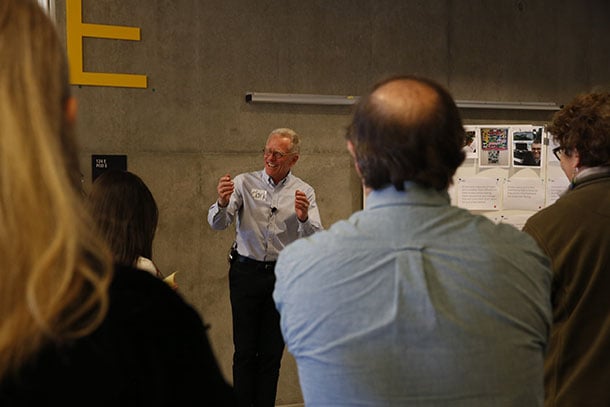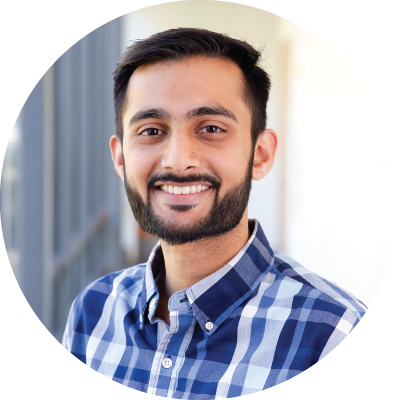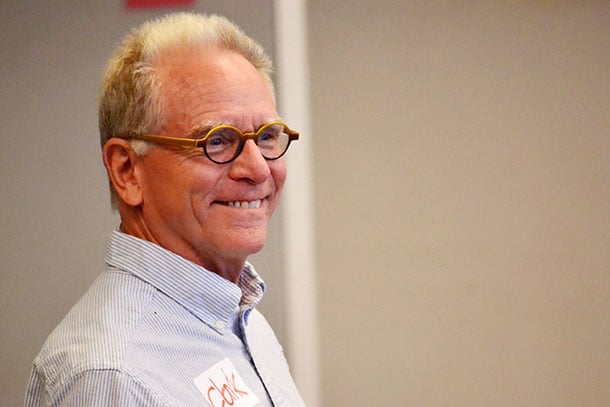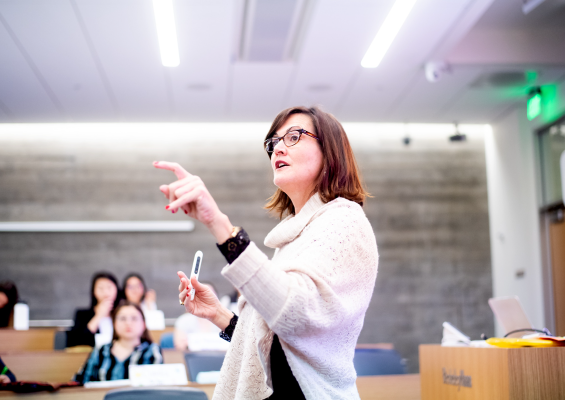A founding partner of The Berkeley Innovation Group, Clark Kellogg has been a pioneer in design thinking. Here the Berkeley MBA lecturer talks about what he teaches: the relevance of creativity and innovation in today’s more complex world.
Why is creativity important for business leaders?
Coming out of WWII, corporate culture was a mirror of military culture. It was hierarchical. It was a command-and-control model. You keep your head down and don’t question the executive. That was the paradigm, and it wasn’t the tradition for business culture to value creativity.
Today the world is in dire straits, and if we keep doing what we’re doing—I’m thinking climate change—we’ll perish. We need to have the capacity to think creatively, to reframe problems, and to be more comfortable with the ambiguous nature of these wicked problems. Design thinking is the Trojan horse that allows us to approach and get inside these problems. It’s a tool kit that helps us confront complex problems that can’t be solved by traditional methods like Six Sigma.
So, what is design thinking?
Design thinking, we often joke, is a bad name for good idea. It came from the design professions and the training we (as designers) received to solve problems by first understanding the users and clients, and to think more creatively about problems—to be open to things that are new.
An easy way to stereotype it is to first think about the traditional process of management consulting. It’s often a hypothesis model. Likely the consultant has an answer in the drawer already that they’ve developed from experience. And it works for well-known problems like improving a supply chain. But it doesn’t work well if you’ve got problems that are very complex or completely new. There you need a process model, not a solutions model.
Discovery and understanding are the first steps. Then you need to immerse yourself in the ecology of the issue so you can define the real problem. Then there is the ideation phrase: ideas without judgment. You sort those out and move on to experimenting and prototyping, and finally arrive at a solution.
The interesting thing is, most of the time you end up solving a problem that was different from the one you thought you had initially.
I think Haas has been admitting a different kind of person."
How do you teach something as ephemeral as creativity and innovation to a room full of quants?
The way I do it is to focus on a series of daily practices that make it non-weird to think differently—a series of repeatable personal practices. Draw every day, or write a poem, or create a piece of art, or keep a journal, or do photography. Every day. These daily practices combine together to create the Practice of Curiosity. This is important because curiosity is always better than judgment.
And it’s not all above the shoulders. We have a life of the mind, the body, and the spirit. In the Creativity Lab course we use physical movement to move creativity around the body. We do some sort of tai chi or meditation, or mindless wandering.
All these things are creatively based, so it’s non-weird to slow down, to see things differently, so that it’s not strange to walk into a room and organize yourself around non-linear thinking.

What is your favorite classroom activity or assignment?
One is I have people draw a self-portrait, an 11x17 with a Sharpie. At first, everyone freaks out, so, I tease them: “How many of you graduated from kindergarten?” I ask. Some of the portraits are stick figures, while others are more complex.
Then I have them annotate the portrait by answering four questions: What is the knowledge you use the most? This forces people to define how they think, the lens through which they see the world. And it forces them to recognize that people have different ways of thinking. The next question is: What are you most passionate about?
The third is: What are your deepest fears? And, yes, I absolutely expect people to be honest with their classmates. It’s a strange level of disclosure. But since many feel they’ve already made fools of themselves with their drawing, it’s always surprising how honest people can be. Finally: What do you do to ground yourself? I call my mom, I run, I ride my motorcycle.
Then you reintroduce yourself to your teammates. You’re in a different world. You know a lot about your teammates, and you need to use that with respect. But a rising level of communication and trust leads to a high level of performance. Communication, trust, and performance lead to a good outcome.
What do you hope your students will take away from your class?
To be competent design thinkers. To develop confidence in their own skills. To not feel ill at ease when they are out of their comfort zone. To become creative leaders and embody the four Haas Defining Leadership Principles.
I think things have changed over the years. My experience is that students at Berkeley Haas have moved from a spot of deep resistance to having a higher tolerance for creative thinking, even embracing it.
I think the reason is that Haas has been admitting a different kind of person. Berkeley is known for greater social awareness. It’s not a place for those who are just looking for a straight line to the corner office. It’s a place where people believe there is a higher probability that we’ll come up with different solutions, and have a better chance of surviving, than if we simply embrace unbridled capitalism.
The expertise and insight your professors bring helps deepen and enhance your MBA journey. By selecting a top school with top-notch professors, you maximize your experience.
Read more from the Take 5 with a professor series:
- Bill Pearce says most important trait of a successful marketer is empathy
- Maura O'Neill says narrow-mindedness is the enemy of innovation
- Dave Rochlin talks flipping the classroom: MBAs learn by doing
- Jennifer Cohen talks equitable and inclusive leadership
- Jenny Chatman gives three benchmarks of an effective organizational culture
- Lucas Davis shares hardest economic concept for MBA students to grasp
- Kellie McElhaney talks equity fluency, courage, and vulnerability









